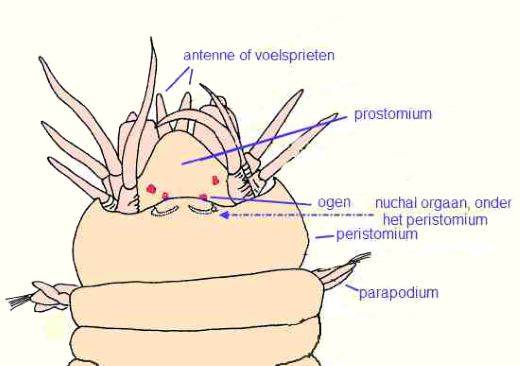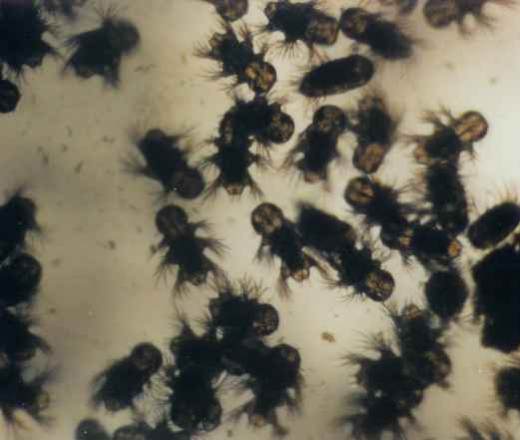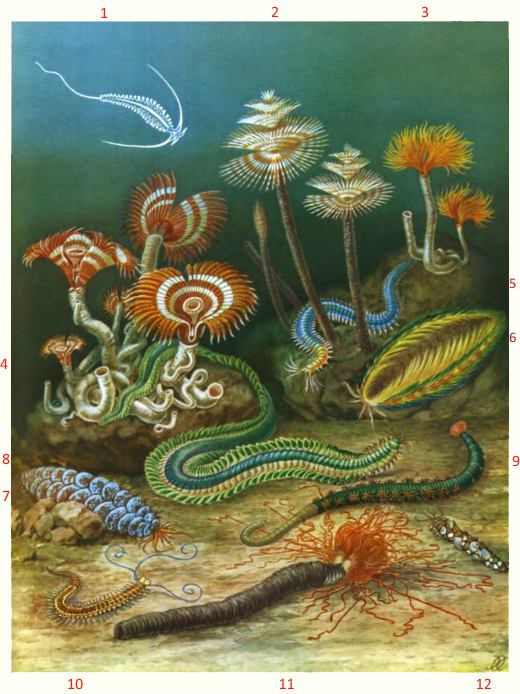Ragworms or sandworms
The ragworm is a marine worm that lives in mudflats. The ragworm lives in a deep tunnel on the seabottom of swallow sandy seas. Ragworms are important a sea-bait, they are harvested by "sandworming".
Sandworm distribution
Sandworms can be found on the East and Westside of the Antartic ocean and in some parts of the Arctic ocean. As the name already indicates they live in the sandy parts of swallow seas, as far south as France off Europe and south to Virginia off the east coast of the United States.
Sandworm spawning
During the evening of the new moon the male sandworms leave there holes and start swarming. The males release there sperm, fertiliziong the females that remains in there holes. The female worms produce a scent that attracts the males. Each female can produce half a miljon eggs that will float in the plankton.
Sandworm feeding
Sandworms are mainly predators who feed on lugworms and amphipods and small bivalves. Nereis virens feeds by capturing a prey with its eversible proboscis which is armed with two strong jaws. They extend part of their digestive tract out of the mouth and grab their prey with their hard jaws. Sandworms are good swimmers, to slow to catch fish but amphipods and lugworms are preyed during swimming. This only happens during the night. Sandsworms that live in captivity can be fed with fish food.

the head of a ragworm or sandworm
Sandworming
Sandworming, or the harvesting of sandworms, is done during low tide from mudflats. The sandworms are collected as a sea-bait. As sandworming disturbs musselgrowth, it has been forbidden on some places to collect them. Also overharvesting before the worms are able to reproduce by spawning has deminshed the amount of sandworms and there seize. For this reason the sandworms are grown commercially nowadays.
 A foto made in a commercially ragworm farm.
When sandworms are only a quarter of a millimeter long, they are grown
on micro algae for 50 to 60 days. These worms are grown in warmed seawater
to give a higher yield. The seawater is warmed by the cooling water from a power plant.
The seawater used to cool the power plants is a byproduct that normally goes to waste.
A foto made in a commercially ragworm farm.
When sandworms are only a quarter of a millimeter long, they are grown
on micro algae for 50 to 60 days. These worms are grown in warmed seawater
to give a higher yield. The seawater is warmed by the cooling water from a power plant.
The seawater used to cool the power plants is a byproduct that normally goes to waste.

Sandworming, a photo made by OneillGT
ragworms and the ecology
Sandworms play an important role in the sandy seas: They are food for many fishes, like flatfish and hering. Ragworms transport minerals from the mud back into the seawater.

Annalid worms of the Arctic and Atlantic oceans.
1 tomopteris renata
2 spirographis spallanzanii
3 mopworm or red fanworm or Protula bispiralis,
4 calcareous tubeworm, fan worm, plume worm or red tube worm or Serpula vermicularis,
5 slender rahworm or Nereis pelagica
6 sea mouse or Aphrodita aculeata
7 Eunoe nodosa
8 ragworm or sandworm, nereis virens
9 lugworm or Arenicola marina
10 Autolytus sp.
11 Amphitrite johnstoni ,a Terebellid worm
12 Onuphis conchilega